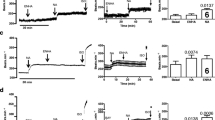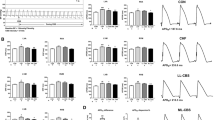Abstract
Regulation of β-adrenoceptor (β-ar) subtypes and transregulation of muscarinic cholinoceptors (mAchr) was examined in regions of rat heart after chronic infusion of (−)-isoprenaline (450 μ/kg per hour) for 14 days. Following (−)-isoprenaline infusion systolic blood pressure was reduced for 10 days but then gradually returned to control levels, whereas heart rate was increased for 7 days before declining to a level significantly above control. Heart weight to body weight ratio was increased in (−)-isoprenaline treated rats. β-ar subtype densities were measured by quantitative autoradiography with [125I]-cyanopindolol (CYP) in sinoatrial node (SA), atrioventricular node (AV), bundle of His (BH), left (LB) and right (RB) bundle branches, interventricular (IVS) and interatrial (IAS) septa, right atria (RA), apex (AX) and mitral valve (MV). β1-ars were reduced by 59.1–74.2% in the AV conducting regions, 53.4% in the SA node and 43.3–53.4% in myocardial areas. β2-ars were markedly reduced in myocardial regions (93.2–98.5%) and in pacemaker and conducting regions (87.7–97.8%). No changes in mAchr densities measured using [3H]-N-methyl scopolamine (NMS) occurred in the AV node, BH, LB, RB, IVS and IAS following (−)-isoprenaline infusion.
Densities of β1- and β2-ars and mAchrs were also measured in ventricular homogenates from control and (−)-isoprenaline treated animals. β-ar levels were significantly reduced (P < 0.05) in treated animals and the ratio of β1- to β2-ars increased after treatment. mAchr density in ventricular homogenates measured using either [3H]-NMS or [3H]-quinuclidinyl [phenyl-4-3H]benzilate (QNB) was unchanged. Homogenates of left and right ventricle also showed no change using [3H]-NMS.
Organ bath studies were used to investigate the effect of (−)-isoprenaline infusion on negative inotropic and chronotropic effects of the non-selective muscarinic receptor agonist bethanechol in left and right atria, respectively. Lower concentrations of bethanechol (3 × 10−10 to 10−6 M) produced a negative inotropic response in isolated electrically driven left atria from (−)-isoprenaline treated rats, but not from control rats, with the slope of the curves being significantly different between groups (ANCOVA, P = 0.037). At concentrations of bethanechol from 10−6 to 3 × 10−4 M the negative inotropic response was not changed between (−)-isoprenaline treated and control animals. Bethanechol also produced a negative chronotropic response at lower concentrations (10−10 to 10−6 M) in (−)-isoprenaline treated rats, but not in controls. A second, steeper phase of the negative chronotropic response occurred at concentrations of bethanechol greater than 10−6 M and was also seen in control rats.
Expression of M2 (cardiac) mAchrs (m2Achr) in left and right ventricular tissues measured using a quantitative non-competitive polymerase chain reaction (PCR) assay showed a significant (P = 0.001) 28.5% increase in expression in left ventricle and a significant (P = 0.003) 21.5% decrease in expression in right ventricle after (−)-isoprenaline treatment, compared to controls. There was no significant difference in total ventricular m2Achr expression between the two groups of rats. The results suggest that chronic β-ar stimulation down-regulates both β1- and β2-ars, and appears to differentially transregulate m2Achr expression, but not mAchr protein. Following (−)-isoprenaline infusion, muscarinic receptor mediated responses were sensitised, with no change in receptor densities, suggesting changes occur in the cell signalling system beyond the level of the receptor.
Similar content being viewed by others
References
Ahlquist RP (1948) A study of adrenotropic receptors. Am J Physiol 153:586–600
Bristow MR, Ginsburg R, Umans V, Fowler M, Minobe W, Rasmussen R, Zera P, Menlove R, Shah P, Jamieson S, Stinson EB (1986) β1- and β2-adrenergic receptor populations in non-failing and failing human ventricular myocardium: coupling of both receptor subtypes to muscle contraction and selective β1 receptor down-regulation in heart failure. Cite Res 59:297–309
Broadley KJ, Chess-Williams RG, Grassby PF (1986) A physiological basis for subclassifying β-adrenoceptors examined by chemical sympathectomy of guinea-pigs. J Physiol (Lond) 373: 367–378
Brodde OE, Schultr S, Kretsch R, Brinkmann M, Borst HG, Hetzer R, Riedmaster JC, Warnecke H, Zerkowski HR (1986) Regional distribution of β-adrenoceptors in the human heart: coexistence of functional β1- and β2-adrenoceptors in both atria and ventricles in severe congestive cardiomyopathy. J Cardiovasc Pharmacol 8:1235–1245
Brodde OE (1991) β1- and β2-adrenoceptors in the human heart: properties, function, and alterations in chronic heart failure. Pharmacol Rev 43:203–242
Chomezynski P, Sacchi N (1987) Single-step method of RNA isolation by acid guanidinium thiocyanate-phenol-chloroform extraction. Anal Biochem 162:156–159
Dooley DJ, Bittiger H, Reymann NC (1986) CGP 20712A: a useful tool for quantitating beta1- and beta2-adrenoceptors. Eur J Pharmacol 130:137–139
Eschenhagen T, Mende U, Schmitz W, Scholz H, Schulte am Esch J, Sempell R, Warnholtz A, Wüstel J-M (1991) Beta-adrenoceptor stimulation-induced increase in cardiac G-protein expression and in carbachol sensitivity. Eur Heart J 12 [Suppl F]: 127–131
Eschenhagen T, Mende U, Diederich M, Nose M, Schmitz W, Scholz H, Schulte am Esch J, Warnholtz A, Schäfer H (1992) Long term β-adrenoceptor-mediated up-regulation of G iα and G0α mRNA levels and pertussis toxin-sensitive guanine nucleotide binding proteins in rat heart. Mol Pharmacol 42:773–783
Fleming JW, Wisler PL, Watanabe AM (1992) Signal transduction by G proteins in cardiac tissue. Circulation 85:420–433
Hadcock JR, Malbon CC (1988) Down-regulation of β-adrenergic receptors: agonist-induced reduction in receptor mRNA levels. Proc Natl Acad Sci USA 85:5021–5025
Hadcock JR, Ros M, Watkins DC, Malbon CC (1990) Cross-regulation between G-protein-mediated pathways. J Biol Chem 265:14784–14790
Harden TK (1983) Agonist-induced desensitisation of β-adrenergic receptor function. Pharmacol Rev 35:5–32
Kaumann AJ (1986) The β1-adrenoceptor antagonist CGP 20712A unmasks β2-adrenoceptors activated by (−)-adrenaline in rat sinoatrial node. Naunyn Schmiedeberg's Arch Pharmacol 332:406–409
Kompa AR, Molenaar P, Summers RJ (1992) Regulation of guinea-pig cardiac β-adrenoceptor subtypes after (−)-adrenaline and (−)-noradrenaline treatment. Molec Neuropharm 1:203–210
Kompa AR, Molenaar P, Summers RJ (1995) Effect of chemical sympathectomy on (−)-isoprenaline-induced changes in cardaic β-adrenoceptor subtypes in the guinea-pig and rat. J Auton Pharmacol 14:411–423
Lands AM, Arnold A, McAuliff JP, Luduena P, Brown TG (1967) Differentiation of receptor systems activated by sympathomimetic amines. Nature 215:597–598
Lowry OH, Rosebrough NJ, Farr AL, Randall RJ (1951) Protein measurement with the folin phenol reagent. J Biol Chem 193:265–275
Lu X, Barnett DB (1990) Differential rates of down-regulation and recovery of rat myocardial β-adrenoceptor subtypes in vivo. Eur J Pharmacol 182:481–486
McPherson GA, Molenaar P, Malta E (1985) The affinity and efficacy of naturally occurring catecholamines at β-adrenoceptor subtypes. J Pharm Pharmacol 37:499–501
Marquetant R, Brehm B, Strasser RH (1992) Chronic β-blockade transregulates inhibitory A1 adenosine and muscarinic M2 receptors of the adenylyl cyclase system. J Mol Cell Cardiol 24:535–548
Mende U, Eschenhagen T, Geertz B, Schmitz W, Scholz H, Schulte am Esch J, Sempell R, Steinfath M (1992) Isoprenaline-induced increase in the 40/41 kDa pertussis toxin substrates and functional consequences on contractile response in rat heart. Naunyn-Schmiedeberg's Arch Pharmacol 345:44–50
Miller JA, Curella P, Zahniser NR (1988) A new densitometric procedure to measure protein levels in tissue slices used in quantitative auto radiography. Brain Res 447:60–66
Minneman KP, Dibner MD, Wolfe BB, Molinoff PB (1979) β1- and β2-adrenergic receptors in rat cerebral cortex are independently regulated. Science 204:866–868
Molenaar P, Summers RJ (1987) Characterisation of beta-1 and beta-2 adrenoceptors in guinea-pig atrium: functional and receptor binding studies. J Pharmacol Exp Ther 241:1041–1047
Molenaar P, Russell FD, Shimada T, Summers RJ (1990a) Densitometric analysis of β1- and β2-adrenoceptors in guinea-pig atrioventricular conducting system. J Mot Cell Cardiol 22:483–495
Molenaar P, Smolich JJ, Russell FD, McMartin LR, Summers RJ (1990b) Differential regulation of beta-1 and beta-2 adrenoceptors in guinea-pig atrioventricular conducting system after chronic (−)-isoprenaline infusion. J Pharmacol Exp Ther 255: 393–400
Morgan K, Wharton J, Webb JC, Keogh BE, Smith PL, Taylor KM, Oakley CM, Polak JM, Cleland JG (1994) Co-expression of renin-angiotensin system component genes in human atrial tissue. J Hypertens Suppl 12:S11–9
Motomura S, Deighton NM, Zerkowski H-R, Doetsch N, Michel MC,Brodde O-E (1990) Chronic β1-adrenoceptor antagonist treatment sensitizes β2-adrenoceptors, but desensitizes M2-mus-carinic receptors in the human right atrium. Br J Pharmacol 101:363–369
Murphree SS, Saffitz JE (1988) Delineation of the distribution of β-adrenergic receptor subtypes in canine myocardium. Circ Res 63:117–125
Nanoff C, Freissmuth E, Schutz W (1989) A different desensitisation pattern of cardiac β-adrenoceptor subtypes by prolonged in vivo infusion of isoprenaline. J Cardiovasc Pharmacol 13: 198–203
Nerme V, Severne Y, Abrahamsson T, Vauquelin G (1985) Endogenous noradrenaline masks beta-adrenergic receptors in rat heart membranes via tight agonist binding. Biochem Pharmacol 34: 2917–2922
Neve KA, McGonigle P, Molinoff PB (1986) Quantitative analysis of the selectivity of radioligands for subtypes of beta adrenergic receptors. J Pharmacol Exp Ther 238:46–53
Ordway GA, Gambarana C, Frazer A (1988) Quantitative autoradiograpby of central beta adrenoceptor subtypes: comparison of the effects of chronic treatment with desipramine or centrally administered l-isoproterenol. J Pharmacol Exp Ther 247:379–389
Quist EE, Lee S-C, Vasan R, Foresman B, Gwirtz P, Jones CE (1994) Chronic sympathectomy of canine cardiac ventricles affects Gs-adenylyl cyclase coupling and muscarinic receptor density. J Cardiovasc Pharmacol 23:936–943
Reithmann C, Gierschik P, Sidiropoulos D, Werden K, Jakobs KH (1989) Mechanism of noradrenaline-induced heterologous desensitization of adenylate cyclase stimulation in rat heart muscle cells: increase in the level of inhibitory G-protein α-subunits. Eur J Pharmacol 172:211–221
Reithmann C, Panzer B, Werdan K (1992) Distinct pathways for β-adrenoceptor-induced up-regulation of muscarinic acetylcholine receptors and inhibitory G-protein α-subunits in chicken cardiomyocytes. Naunyn-Schmiedeberg's Arch Pharmacol 345: 530–540
Russell FD, Kompa AR, Molenaar P, Summers RJ (1994) Regulation of β-adrenoceptors in the guinea-pig sinoatrial node. Naunyn-Schmiedeberg's Arch Pharmacol 349:463–472
Sarsero D, Molenaar P (1995) Effects of chronic infusion of (−)-isoprenaline on rat cardiac (M2)-cholinoceptors and β1- and β2-adrenoceptors. J Auton Pharmacol, 15:239–255
Sibley DR, Lefkowitz RJ (1985) Molecular mechanisms of receptor desensitisation using the β-adrenergic receptor-coupled adenylate cyclase system as a model. Nature 17:124–129
Williams DW, Summers RJ (1990) Simul-an accurate method for the determination of receptor subtype proportions using a personal computer. Comput Methods Programs Biomed 32:137–140
Young III WS, Kuhar MJ (1979) A new method for receptor autoradiography: [3H]-opioid receptors in rat brain. Brain Res 179:255–270
Author information
Authors and Affiliations
Rights and permissions
About this article
Cite this article
Matthews, J.M., Falckh, P.H., Molenaar, P. et al. Chronic (−)-isoprenaline infusion down-regulates β1- and β2-adrenoceptors but does not transregulate muscarinic cholinoceptors in rat heart. Naunyn-Schmiedeberg's Arch Pharmacol 353, 213–225 (1996). https://doi.org/10.1007/BF00168760
Received:
Accepted:
Issue Date:
DOI: https://doi.org/10.1007/BF00168760




